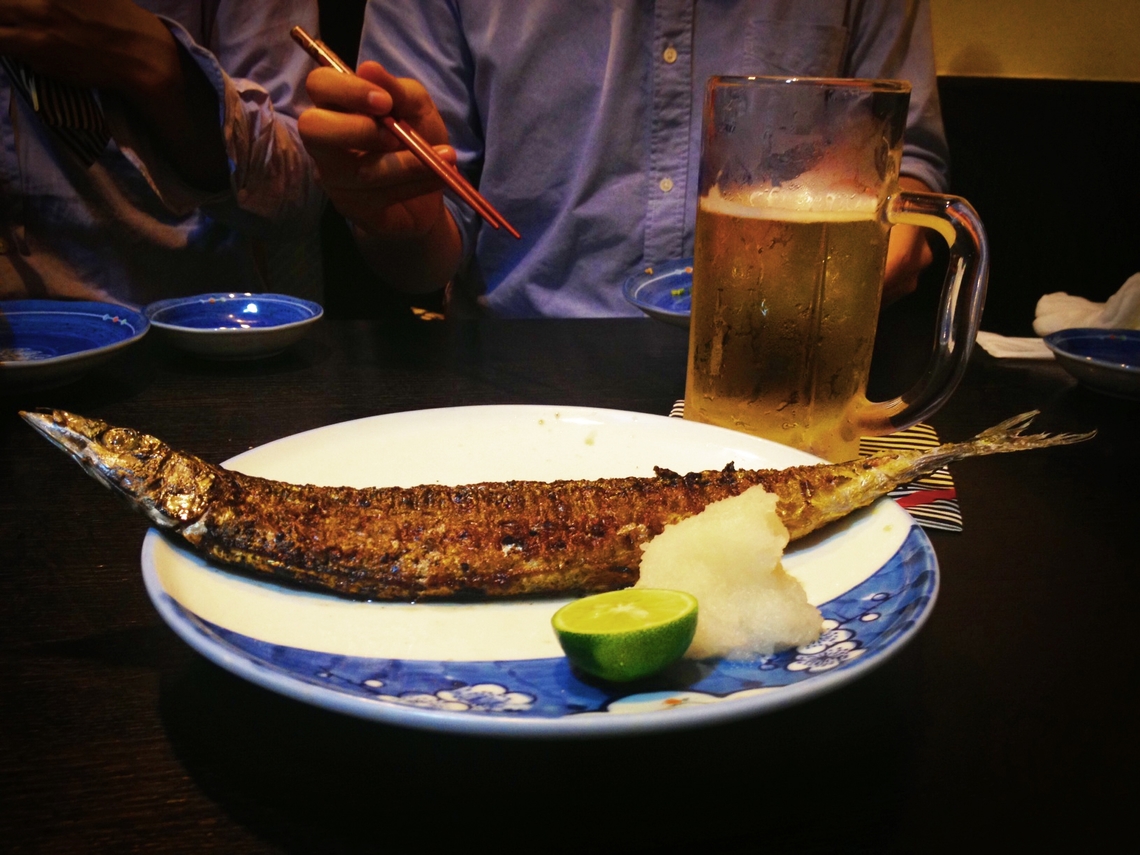Today, junior copywriters Mr. Kakamigahara and Mr. Sato, along with art director Mr. Takahashi, gathered at a local izakaya to reflect on a stalled project. Chewing on sweet whelks, they lamented, "It was such a good plan this time. I'm so sorry!" "No, it's my fault." "No, it's mine." Over seared bonito and tuna sashimi, they ordered more beer, muttering, "It's frustrating," and "It was fun though."

The taste of the season!
"Huh? Try the saury liver."
"Sanma, sanma, sanma—bitter or salty? I spent my middle and high school years in a corner of Musashino, where Sato Haruo wrote 'The Song of the Pacific Saury' and later penned 'The Melancholy of the Countryside'. My fandom for Kudo Yuki-san goes back to those days too—now over 30 years..."
"I'm prepared to support the yellow member of a certain idol group for life, but hearing your story, Yamada-san, gave me courage!"
As usual, it gradually became a bright, relentlessly cheerful debriefing session with no real coherence. I know I shouldn't drink too much since it's a job that requires brainpower, but I often suffer from hangovers at the office. Sorry about that.

From left: Takahashi-san, Sato-san, Kagami-san. Already in high spirits.
By the way, young copywriters like Mr. Kakamigahara and Mr. Sato sometimes get assigned homework like "Come up with 100 copy ideas by tomorrow." This is the very practice of what we call "scatter mode" in circular thinking. It's not just about tweaking particles like "te ni wa ha." It's about bouncing back and forth between every possible aspect of people (the target audience) and every possible aspect of things and events, seeking "new connections." The more you think about it realistically, the more you lay bare your own life experiences and inner self. It's a lonely, embarrassing, painful process – literally a process of rolling around in agony.
According to Kentaro Kimura and Mitsuki Isobe※1, the "thinking logic" used during this process can be categorized into eight types.
【Two Analytical Logics】
① The "syllogism (deductive reasoning)" connected by the conjunction "therefore"
② "Inductive reasoning" that builds evidence and derives a conclusion from it
【6 Types of Ideation Logic】
③ "Association": A implies B, B implies C
④ Combining A and B: "Combination"
⑤ "Analogy": Generating ideas using similar things as hints
⑥ "Hypothesis Method (Abduction)" – Inferring "What this implies"
⑦ "Virtual Scenarios": Considering "what if" from situations detached from reality
⑧ "Reversal": Thinking of ideas 180 degrees opposite to common sense
I think everyone has their own tricks for generating ideas, but it seems all of them can be explained as combinations of these eight thinking logics. For example, I often try "thinking to extremes." If the product is "strawberry juice," I might ask, "What would 'sexy strawberry juice' be?" or "What if strawberry juice caused divorce?" The goal is to break fixed notions and broaden the scope of ideas.
In terms of thinking logic, this would be based on "hypothetical" scenarios while also utilizing "association" and "combination."

Enjoying it with refreshing aromatic vegetables is this shop's style.
In scattered mode, we employ all sorts of tricks to seek "new connections." Regardless of the thought process, it ultimately boils down to recalling (or pulling out) material accumulated within ourselves. Positively put, "Your ideas are unique to you. ※2" But we often agonize, thinking, "I can't come up with ideas because my inner world is barren."
Before engaging in such earnest, tumultuous battles, suffering from a hangover is simply unacceptable. Once again, my apologies!
Next time, let's talk about this "Scatter Mode" and "Rapid Prototyping."
Enjoy!
※1 Excerpted from Breakthrough: Inspiration Comes from Logic by Kentaro Kimura and Mitsuki Isobe, Sendenkaigi, 2013. A well-organized and stimulating book.
※2 Excerpted from Kotaro Sugiyama, Creative Mind, Impress Japan, 2011.





